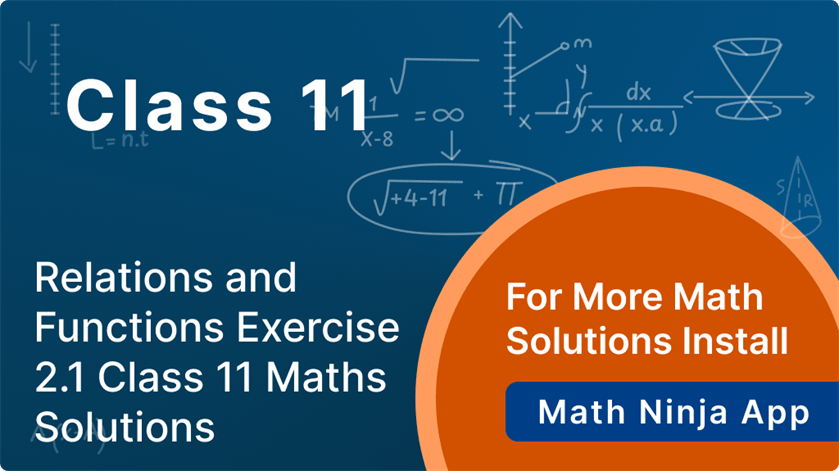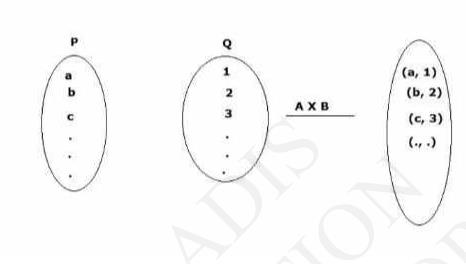class 11 maths ncert solutions || ncert exemplar class 11 maths || ncert solutions for class 11 maths chapter 2 || class 11 maths relations and functions || exercise 2.1 class 11 maths solutions || class 11 chapter 2 exercise 2.1 solution || class 11 ch 2 exercise 2.1 solutions
Looking for Ex 2.1 Class 11 Maths NCERT Solutions? You’re in the right place! This section offers clear, step-by-step solutions for all the questions in Exercise 2.1 from Chapter 2 – Relations and Functions. The Class 11 Maths Chapter 2 Exercise 2.1 Solutions are designed to strengthen your understanding of these basic yet important concepts, forming the base for advanced topics in mathematics. These solutions strictly follow the CBSE syllabus, helping you stay aligned with your exam preparation. Go through Class 11 Maths Relations and Functions Exercise 2.1 thoroughly to enhance your conceptual clarity and problem-solving skills.

class 11 maths ncert solutions || ncert exemplar class 11 maths || ncert solutions for class 11 maths chapter 2 || class 11 maths relations and functions || exercise 2.1 class 11 maths solutions || class 11 chapter 2 exercise 2.1 solution || class 11 ch 2 exercise 2.1 solutions
Exercise 2.1
1. If, \( \left(\frac{x}{3}+1, y-\frac{2}{3}\right)=\left(\frac{5}{3}, \frac{1}{3}\right) \) find the values of \(x\) and \(y \).
Answer
Given: \( \left(\frac{x}{3}+1, y-\frac{2}{3}\right)=\left(\frac{5}{3}, \frac{1}{3}\right) \)
Since the ordered pairs are equal, the corresponding elements are equal.
Therefore, \( \frac{x}{3}+1=\frac{5}{3} \) and \( y-\frac{2}{3}=\frac{1}{3} \)
\(\frac{x}{3}=\frac{5}{3}-1 \text { and } y=\frac{1}{3}+\frac{2}{3}\)
\(\frac{x}{3}=\frac{5-3}{3} \text { and } y=\frac{1+2}{3}\)
\(\frac{x}{3}=\frac{2}{3} \quad \text { and } y=\frac{3}{3}\)
Hence by solving we get, \( x=2 \) and \( y=1 \).
2. If the set \( A \) has 3 elements and the set \( B=\{3,4,5\} \), then find the number of elements in \( (\mathrm{A} \times \mathrm{B}) \).
Answer
Given: Set A has 3 elements and the set \( \mathrm{B}=\{3,4,5\} \)
As we see the number of elements in set \( \mathrm{B}=3 \).
Number of elements in \( (A \times B)=( \) Number of elements in set \( A) \times \) (Number of elements in B)
\(\Rightarrow \mathrm{n}(\mathrm{A} \times \mathrm{B})=\mathrm{n}(\mathrm{A}) \times \mathrm{n}(\mathrm{B})\)
\(\Rightarrow \mathrm{n}(\mathrm{A} \times \mathrm{B})=3 \times 3\)
\(\Rightarrow \mathrm{n}(\mathrm{A} \times \mathrm{B})=9\)
Hence, the number of elements in \( (A \times B)=9 \).
3. If \( G=\{7,8\} \) and \( H=\{5,4,2\} \), find \( G \times H \) and \( H \times G \).
Answer
Given: \( \mathrm{G}=\{7,8\} \) and \( \mathrm{H}=\{5,4,2\} \)
By definition of Cartesian product of two non-empty Set \(P\) and \(Q\) :
\(P \times Q=\{(p, q): p \in P, q \in Q\}\)
Therefore, \( \mathrm{G} \times \mathrm{H}=\{(7,5),(7,4),(7,2),(8,5),(8,4),(8,2)\} \).
And \( \mathrm{H} \times \mathrm{G}=\{(5,7),(5,8),(4,7),(4,8),(2,7),(2,8)\} \).
4. State whether each of the following statements are true or false. If the statement is false, rewrite the given statement correctly.
(i) If \( \mathrm{P}=\{\mathrm{m}, \mathrm{n}\} \) and \( \mathrm{Q}=\{\mathrm{n}, \mathrm{m}\} \), then \( \mathrm{P} \times \mathrm{Q}=\{(\mathrm{m}, \mathrm{n}),(\mathrm{n}, \mathrm{m})\} \).
(ii) If A and B are non-empty sets, then \( \mathrm{A} \times \mathrm{B} \) is a non-empty set of ordered pairs ( \( x, y \) ) such that \( x \in A \) and \( y \in B \).
(iii) If \( \mathrm{A}=\{1,2\}, \mathrm{B}=\{3,4\} \), then \( \mathrm{A} \times(\mathrm{B} \cap \phi)=\phi \).
(i) If \( \mathrm{P}=\{\mathrm{m}, \mathrm{n}\} \) and \( \mathrm{Q}=\{\mathrm{n}, \mathrm{m}\} \), then \( \mathrm{P} \times \mathrm{Q}=\{(\mathrm{m}, \mathrm{n}),(\mathrm{n}, \mathrm{m})\} \).
(ii) If A and B are non-empty sets, then \( \mathrm{A} \times \mathrm{B} \) is a non-empty set of ordered pairs ( \( x, y \) ) such that \( x \in A \) and \( y \in B \).
(iii) If \( \mathrm{A}=\{1,2\}, \mathrm{B}=\{3,4\} \), then \( \mathrm{A} \times(\mathrm{B} \cap \phi)=\phi \).
Answer
(i) Given: \( \mathrm{P}=\{\mathrm{m}, \mathrm{n}\} \) and \( \mathrm{Q}=\{\mathrm{n}, \mathrm{m}\} \)
By definition of Cartesian product of two non-empty Set \(P\) and \(Q\) :
\(P \times Q=\{(p, q): p \in P, q \in Q\}\)
Therefore, \( P \times Q=\{(m, n),(m, m),(n, m),(n, n)\} \).
\(\Rightarrow \mathrm{P} \times \mathrm{Q} \neq\{(\mathrm{m}, \mathrm{n}),(\mathrm{n}, \mathrm{m})\}\)
Hence, the statement is false.
(ii) Given: A and B are non-empty sets and \( x \in \mathrm{A} \) and \( y \in \mathrm{B} \).
By definition of Cartesian product of two non-empty Set P and Q :
\(\mathrm{P} \times \mathrm{Q}=\{(\mathrm{p}, \mathrm{q}): \mathrm{p} \in \mathrm{P}, \mathrm{q} \in \mathrm{Q}\}\)
\(\Rightarrow \mathrm{A} \times \mathrm{B}=\{(x, y): x \in \mathrm{A}, y \in \mathrm{B}\}\)
Hence, the statement is true.
(iii) Given: \( \mathrm{A}=\{1,2\}, \mathrm{B}=\{3,4\} \)
To Prove: \( \mathrm{A} \times(\mathrm{B} \cap \phi)=\phi \).
As \( (B \cap \phi)=\phi \)
By definition if either of the two set P and Q is null set then \( \mathrm{P} \times \mathrm{Q} \) will also be a null set. i.e. \( \mathrm{P} \times \mathrm{Q}=\phi \).
\(\Rightarrow \mathrm{A} \times(\mathrm{B} \cap \phi)=\phi\)
Hence, the statement is true.
class 11 maths ncert solutions || ncert exemplar class 11 maths || ncert solutions for class 11 maths chapter 2 || class 11 maths relations and functions || exercise 2.1 class 11 maths solutions || class 11 chapter 2 exercise 2.1 solution || class 11 ch 2 exercise 2.1 solutions
5. If \( \mathrm{A}=\{-1,1\} \), find \( \mathrm{A} \times \mathrm{A} \times \mathrm{A} \).
Answer
Given: \( \mathrm{A}=\{-1,1\} \)
Cartesian product of a two sets A and B is given by set of multiplication of every member of the set with every other member of the set. Thus pairs of members of set are formed.
For given \( \mathrm{A}, \mathrm{A} \times \mathrm{A}=\{-1,1\} \times\{-1,1\} \)
\(\mathrm{A} \times \mathrm{A}=\{(-1,-1),(-1,1),(1,-1),(1,1)\}\)
Now,
By definition \( \mathrm{A} \times \mathrm{A} \times \mathrm{A}=\{(\mathrm{a}, \mathrm{b}, \mathrm{c}): \mathrm{a}, \mathrm{b}, \mathrm{c} \in \mathrm{A}\} \).
\(\Rightarrow \mathrm{A} \times \mathrm{A} \times \mathrm{A}=\{(-1,-1,-1),(-1,-1,1),(-1,1,-1),(1,-1,-1),(-1,1,1)\)
\((1,-1,1),(1,1,-1),(1,1,1)\}\)
6. If \( \mathrm{A} \times \mathrm{B}=\{(\mathrm{a}, x),(\mathrm{a}, y),(\mathrm{b}, x),(\mathrm{b}, y)\} \). Find A and B .
Answer
Given: \( \mathrm{A} \times \mathrm{B}=\{(\mathrm{a}, x),(\mathrm{a}, y),(\mathrm{b}, x),(\mathrm{b}, y)\} \)
By definition of Cartesian product of two non-empty Set \(P\) and \(Q\) :
\(P \times Q=\{(p, q): p \in P, q \in Q\}\)
Hence, we see \( \mathrm{A}= \) set of all first elements.
\( B= \) set of all second elements.
\( \Rightarrow \mathrm{A}=\{\mathrm{a}, \mathrm{b}\} \) and \( \mathrm{B}=\{x, y\} \).
7.
(i) Let \( \mathrm{A}=\{1,2\}, \mathrm{B}=\{1,2,3,4\}, \mathrm{C}=\{5,6\} \) and \( \mathrm{D}=\{5,6,7,8\} \). Verify that
\( A \times(B \cap C)=(A \times B) \cap(A \times C) \).
\( A \times(B \cap C)=(A \times B) \cap(A \times C) \).
Answer
Given: \( \mathrm{A}=\{1,2\}, \mathrm{B}=\{1,2,3,4\}, \mathrm{C}=\{5,6\} \) and \( \mathrm{D}=\{5,6,7,8\} \)
To verify: \( A \times(B \cap C)=(A \times B) \cap(A \times C) \)
As we see, \( \mathrm{B} \cap \mathrm{C}=\{1,2,3,4\} \cap\{5,6\}=\phi \).
By definition if either of the two set P and Q is null set then \( \mathrm{P} \times \mathrm{Q} \) will also be a null set. i.e. \( \mathrm{P} \times \mathrm{Q}=\phi \).
\( A \times(B \cap C)=\phi \ldots (1\) )
Now, \( (\mathrm{A} \times \mathrm{B})=\{(1,1),(1,2),(1,3),(1,4),(2,1),(2,2),(2,3),(2,4)\} \)
And \( (\mathrm{A} \times \mathrm{C})=\{(1,5),(1,6),(2,5),(2,6)\} \)
\( (\mathrm{A} \times \mathrm{B}) \cap(\mathrm{A} \times \mathrm{C})=\phi \ldots(2) \)
From (1) and (2)
\( A \times(B \cap C)=(A \times B) \cap(A \times C) \)
(ii) Let \( \mathrm{A}=\{1,2\}, \mathrm{B}=\{1,2,3,4\}, \mathrm{C}=\{5,6\} \) and \( \mathrm{D}=\{5,6,7,8\} \). Verify that
\( A \times C \) is a subset of \( B \times D \).
\( A \times C \) is a subset of \( B \times D \).
Answer
Given: \( \mathrm{A}=\{1,2\}, \mathrm{B}=\{1,2,3,4\}, \mathrm{C}=\{5,6\} \) and \( \mathrm{D}=\{5,6,7,8\} \)
To verify: \( A \times C \) is a subset of \( B \times D \).
\((\mathrm{A} \times \mathrm{C})=\{(1,5),(1,6),(2,5),(2,6)\}\)
\((\mathrm{B} \times \mathrm{D})=\{(1,5),(1,6),(1,7),(1,8),(2,5),(2,6),(2,7),(2,8),(3,5),(3,6),\)
\((3,7),(3,8),(4,5),(4,6),(4,7),(4,8)\}\)
As we see all the elements of set \( A \times B \) are there in set \( B \times D \).
Hence, \( A \times C \) is a subset of \( B \times D \).
8. Let \( A=\{1,2\} \) and \( B=\{3,4\} \). Write \( A \times B \). How many subsets will \( \mathrm{A} \times \mathrm{B} \) have? List them.
Answer
Given: \( \mathrm{A}=\{1,2\} \) and \( \mathrm{B}=\{3,4\} \)
\((\mathrm{A} \times \mathrm{B})=\{(1,3),(1,4),(2,3),(2,4)\}\)
Number of elements in \( (A \times B)=4 \)
\(\Rightarrow \mathrm{n}(\mathrm{A} \times \mathrm{B})=4\)
Then number of subsets of \( \operatorname{set}(A \times B)=2 n=24=16 \)
\( \Rightarrow \) number of subsets of \( \operatorname{set}(A \times B)=16 \)
These are:
\(\{\phi\},\{(1,3)\},\{(1,4)\},\{(2,3)\},\{(2,4)\},\{(1,3),(1,4)\},\{(1,3),(2,3)\},\)
\(\{(1,3),(2,4)\},\{(1,4),(2,3)\},\{(1,4),(2,4)\},\{(2,3),(2,4)\},\{(1,3),(1,4)\)
\((2,3)\},\{(1,3),(1,4),(2,4)\},\{(1,4),(2,3),(2,4)\},\{(1,3),(2,3),(2,4)\}\)
\(\{(1,3),(1,4),(2,3),(2,4)\} .\)
9. Let \( A \) and \( B \) be two sets such that \( \mathrm{n}(A)=3 \) and \( \mathrm{n}(B)=2 \). If \( (x, 1) \), \( (y, 2),(z, 1) \) are in \( \mathrm{A} \times \mathrm{B} \), find A and B , where \( x, y \) and \( z \) are distinct elements.
Answer
Given: \( \mathrm{n}(\mathrm{A})=3 \) and \( \mathrm{n}(\mathrm{B})=2 \) and If \( (x, 1),(y, 2),(z, 1) \) are in \( \mathrm{A} \times \mathrm{B} \).
By definition of Cartesian product of two non-empty Set P and Q : \( P \times Q=\{(p, q): p \in P, q \in Q\} \)
It means graphically as,

Hence, we see \( \mathrm{P}= \) set of all first elements.
\( \mathrm{Q}= \) set of all second elements.
\( \Rightarrow(x, y, z) \) are elements of A and \( (1,2) \) are elements of B .
\( \Rightarrow \mathrm{As} \mathrm{n}(\mathrm{A})=3 \) and \( \mathrm{n}(\mathrm{B})=2 \) so, \( \mathrm{A}=\{x, y, z\} \) and \( \mathrm{B}=\{1,2\} \).
10. The Cartesian product \( \mathrm{A} \times \mathrm{A} \) has 9 elements among which are found \( (-1,0) \) and \( (0,1) \). Find the set A and the remaining elements of A \( \times \) A.
Answer
Given: Cartesian product \( \mathrm{A} \times \mathrm{A} \) having 9 elements among which are found \( (-1,0) \) and \( (0,1) \).
Number of elements in \( (A \times B)=( \) Number of elements in set \( A) \times \) (Number of elements in B)
\(\Rightarrow \mathrm{n}(\mathrm{A} \times \mathrm{A})=\mathrm{n}(\mathrm{A}) \times \mathrm{n}(\mathrm{A})\)
\(\Rightarrow \mathrm{n}(\mathrm{A} \times \mathrm{A})=9 \text { (given) }\)
\(\Rightarrow \mathrm{n}(\mathrm{A}) \times \mathrm{n}(\mathrm{A})=9\)
\(\Rightarrow \mathrm{n}(\mathrm{A})=3\)
By definition \( \mathrm{A} \times \mathrm{A}=\{(\mathrm{a}, \mathrm{a}): \mathrm{a} \in \mathrm{A}\} \).
Therefore, \( -1,0 \) and 1 are the elements of set A .
Because, \( \mathrm{n}(\mathrm{A})=3 \) therefore, \( \mathrm{A}=\{-1,0,1\} \).
Hence the remaining elements of set \( (\mathrm{A} \times \mathrm{A}) \) are: \( (-1,-1),(-1,1),(0,0),(0,-1),(1,1),(1,-1) \) and \( (1,0) \).

